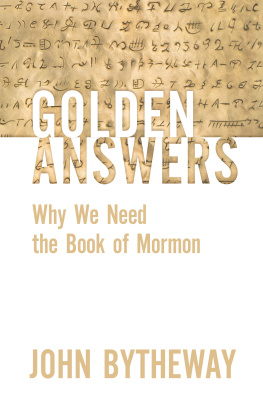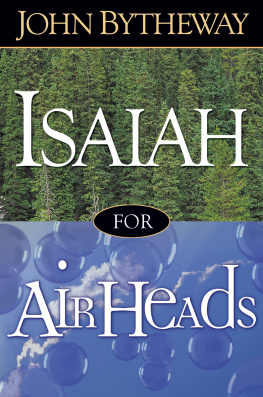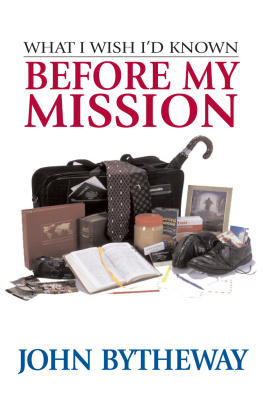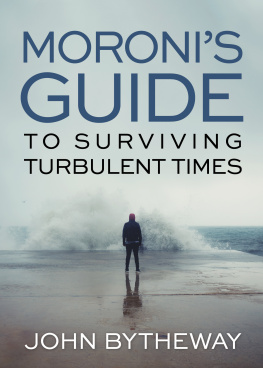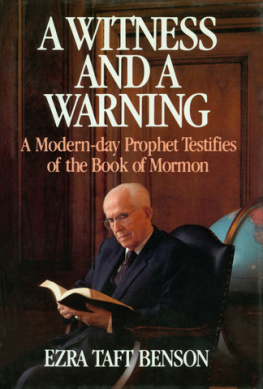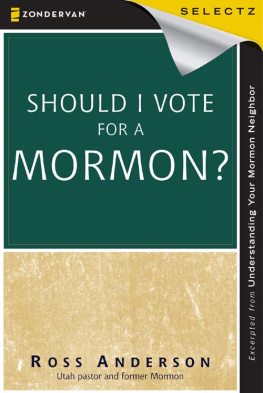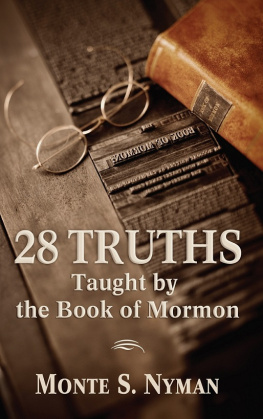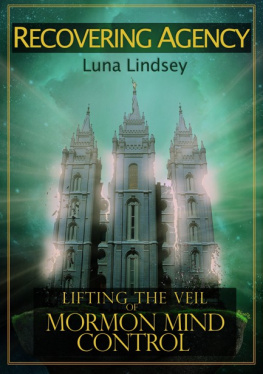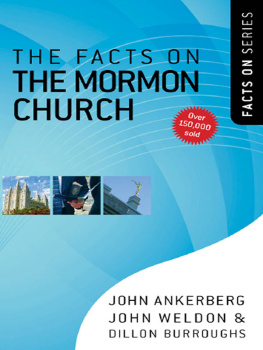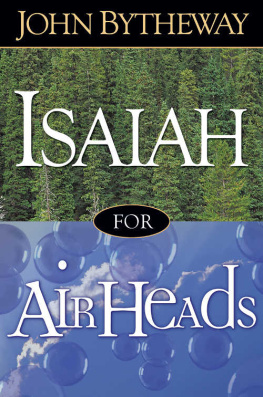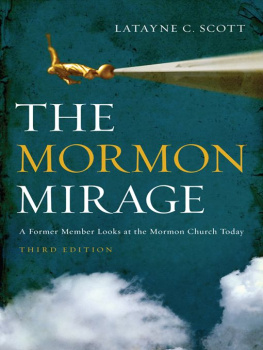About the Author
John Bytheway served a mission to the Philippines and later graduated from Brigham Young University. He has a masters degree in religious education and is a part-time instructor at the BYU Salt Lake Center. John is the author of many bestselling books, audio talks, and DVDs, including How Do I Know if I Know? ; Isaiah for Airheads ; and Righteous Warriors: Lessons from the War Chapters in the Book of Mormon . He and his wife, Kimberly, have six children.
2020 John Bytheway
All rights reserved. No part of this book may be reproduced in any form or by any means without permission in writing from the publisher, Deseret Book Company, at permissions@deseretbook.com or PO Box 30178, Salt Lake City, Utah 84130. This work is not an official publication of The Church of Jesus Christ of Latter-day Saints. The views expressed herein are the responsibility of the author and do not necessarily represent the position of the Church or of Deseret Book Company.
Deseret Book is a registered trademark of Deseret Book Company.
Visit us at deseretbook.com
Library of Congress Cataloging-in-Publication Data
Names: Bytheway, John, 1962 author.
Title: Golden answers : why we need The Book of Mormon / John Bytheway.
Description: Salt Lake City, Utah : Deseret Book, [2020] | Includes bibliographical references. | Summary: Author John Bytheway explains why the Book of Mormon is essential to our understanding of the gospel of Jesus Christ Provided by publisher.
Identifiers: LCCN 2019041842 | ISBN 9781629727257 (trade paperback) | eISBN 978-1-62973-935-9
Subjects: LCSH: The Church of Jesus Christ of Latter-day SaintsDoctrines. | Book of MormonCriticism, interpretation, etc. | Spiritual lifeThe Church of Jesus Christ of Latter-day Saints. | Spiritual lifeMormon Church. | Christian lifeMormon authors. | Plan of salvation (Mormon theology) | Mormon ChurchDoctrines.
Classification: LCC BX8656 .B98 2020 | DDC 230/.93dc23
LC record available at https://lccn.loc.gov/2019041842
Printed in the United States of America
PubLitho, Draper, UT
10 9 8 7 6 5 4 3 2 1
Book design Deseret Book Company
Cover photo by Welden Andersen Intellectual Reserve, Inc. Used by permission
Design by Shauna Gibby
Contents
Chapter One
Im Thirsty; Where Did You Get That?
This may be the most important class you will ever take, I often begin. Not because of your instructor, I continue, but because of our textbook. Thankfully, we will not be judged by the material in our biology textbook, or our history textbook, or our macroeconomics textbook (thank heavens), but we when we face the final judgment, this book, the Book of Mormon, will be mentioned by the Lord himself when he asks, Did I not declare my words unto you, which were written by this man, like as one crying from the dead, yea, even as one speaking out of the dust? (Moroni 10:27).
I have recently had the opportunity to teach a relatively new class, which in institute of religion lingo is called Religion 275. In this class, rather than teaching the Book of Mormon by starting in 1 Nephi and going chapter by chapter through Moroni 10, we focus on Doctrines and Teachings of the Book of Mormon.
At first, I confess that I thought, Here we go again with yet another way of doing things, and how am I supposed to condense all of this into one semester? However, I scrapped my old lesson plans and began to read and research and create new ones. After a few weeks, I found myself repenting and thanking heaven for this new approach. I discovered again, and appreciated more than ever before, the uniqueness and the clarifying power of the Book of Mormon.
As a teacher, I have been humbled and grateful for the young and curious students who have entered my classroom. On the first day of class, I always ask them to stand and introduce themselves to each other. I invite them to share some biographical information, like where they live, their missionary service, if any, and something fun, like their favorite fast-food restaurant (In-N-Out usually wins, by the way). They come from all over the country and have served all over the world.
As we begin on the first day, I often introduce the course by asking my well-traveled students, Does water taste different in different parts of the country, or in different parts of the world? Everyone answers with an affirmative nod or a spoken Yes.
We then begin a discussion on the importance of water, arguably the most vital substance on earth. How long can one survive without water? Only a few days. Scientists have a probe or two on the planet Mars right now. What are they looking for? Water. Because if there is water, there could be life!
At this point, I try to introduce my own little parable (which is not all that profound, as parables go, but here it is):
A wandering traveler, lost, thirsty, and desperate, discovered a beautiful mountain lake. He excitedly dropped his belongings on the shore, got on his hands and knees, and drank the lifesaving liquid deeply and gratefully. As he swallowed the cool water, he felt it soothe his parched throat, restore his energy, and bolster his spirit. Then he rolled onto his back, closed his eyes, and sighed in gratitude.
Suddenly, he discovered he was not alone, as a man who lived near the waters approached him quietly and asked, Do you know why this water tastes so good?
Yes, the weary traveler replied, because I had been without water for so long, and I was very thirsty.
Indeed, answered the man, but theres more. Look over there, he gestured, and as the traveler looked toward the east, he saw a vast mountain range and a stream flowing from it into the lake. The stream from those mountains gives the water its minerals and rich taste. Now look over to the other side. What do you see? The traveler looked west and saw a small waterfall forming another river, which fed the lake from the west. That tributary gives this water its coolness and freshness. But thats not all, the man continued. This lake is also fed by a spring that you cannot see. And in certain seasons, as heavy clouds approach these mountains, they release their abundant moisture, creating a runoff that keeps the lake full to overflowing. This body of water would be diminished without any one of them. Each of these sources contributes to the beauty of the lake and the quality of this pure, refreshing liquid.
Thank you. I really didnt know any of that until now, and I probably wouldnt have thought of it unless you explained it, replied the traveler. All I know is that it was delicious to me. It renewed my soul, filled me with hope, and gave me exactly what I needed. Then the traveler paused for a moment and continued, But after today, I will respect and appreciate everything connected to this lake. Not only is it the best water Ive ever tasted, but it saved my life.
So theres my amateur parable. You probably already know where Im going with this, which is the nice thing about parables. Elder David A. Bednar taught:
The scriptures contain the words of Christ and are a reservoir of living water to which we have ready access and from which we can drink deeply and long. (A Reservoir of Living Water, BYU Devotional, February 4, 2007)
We might call our own testimonies and gospel knowledge our personal reservoir. For the most part, my young adult students know the fundamentals of the gospel. They have a good-sized reservoir of gospel knowledge. Theyve heard countless Primary and Sunday School lessons, seminary classes, and Come, Follow Me lessons. But what is the source, the primary source, for all of this knowledge? (If theres one thing I remember from my masters program in Religious Education, it was to always go to primary sourcesthey drummed it into us every day.) The source material for all these teachings that comprise our reservoir are the revelations from the Lord, or, in other words, the scriptures.

